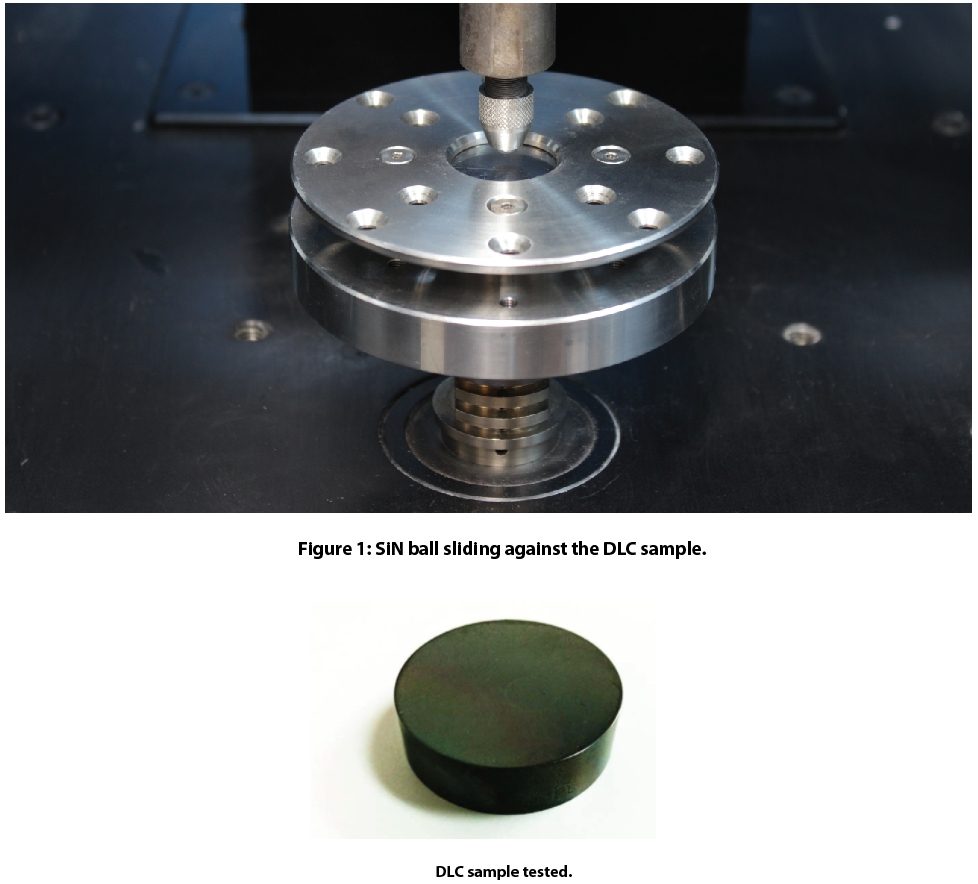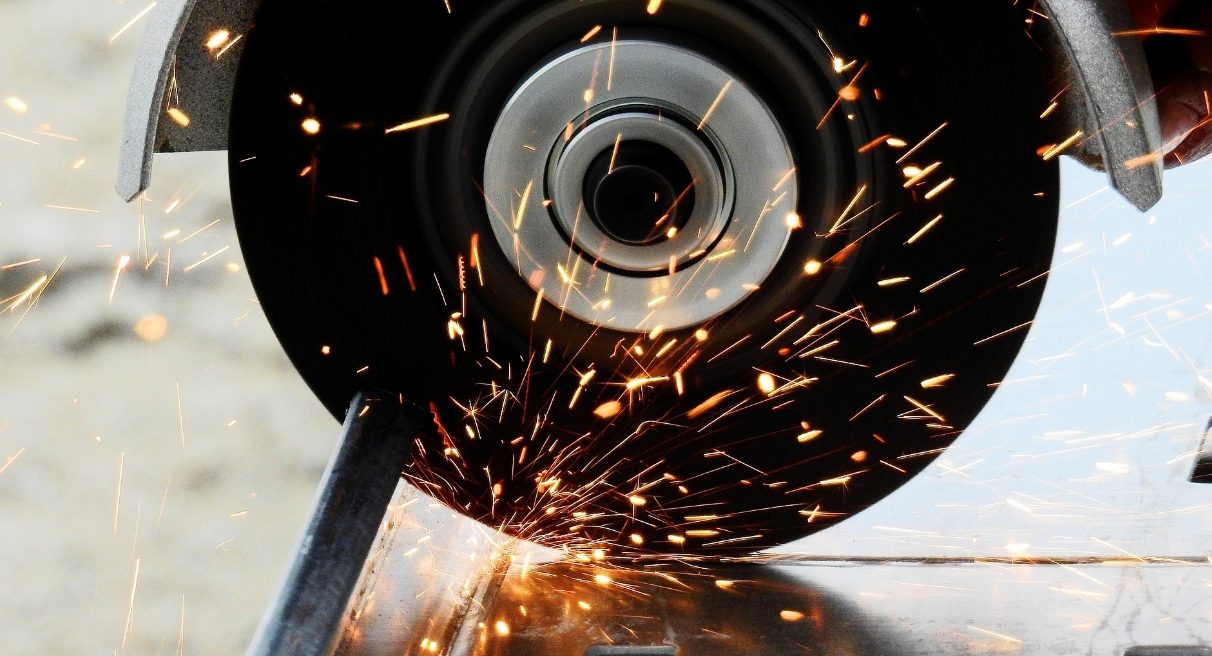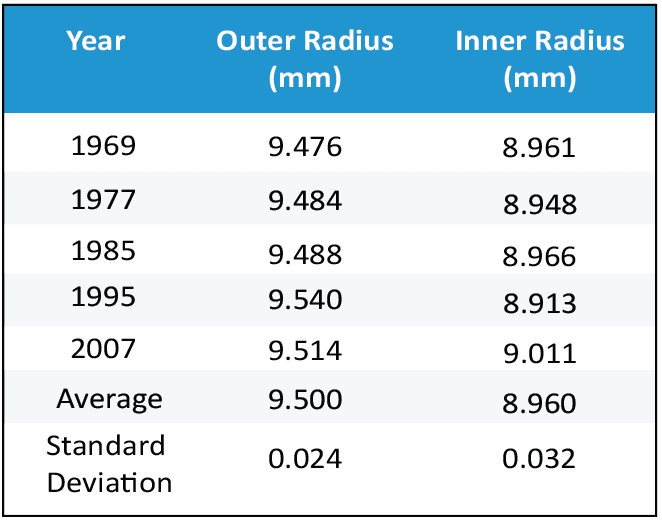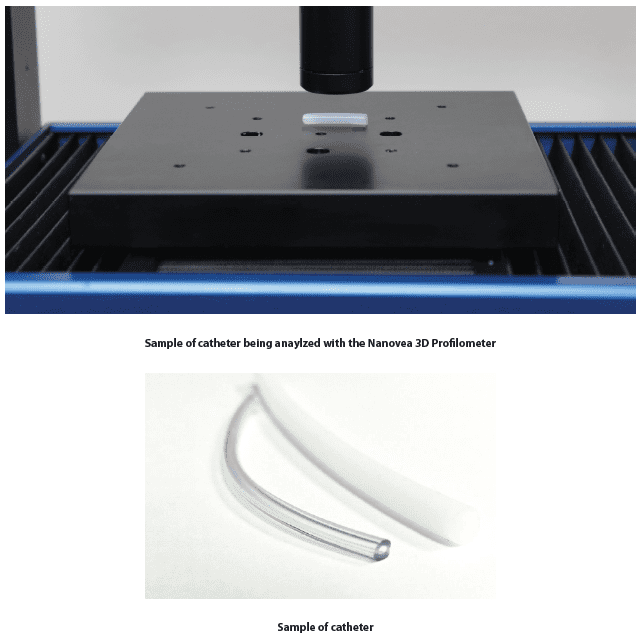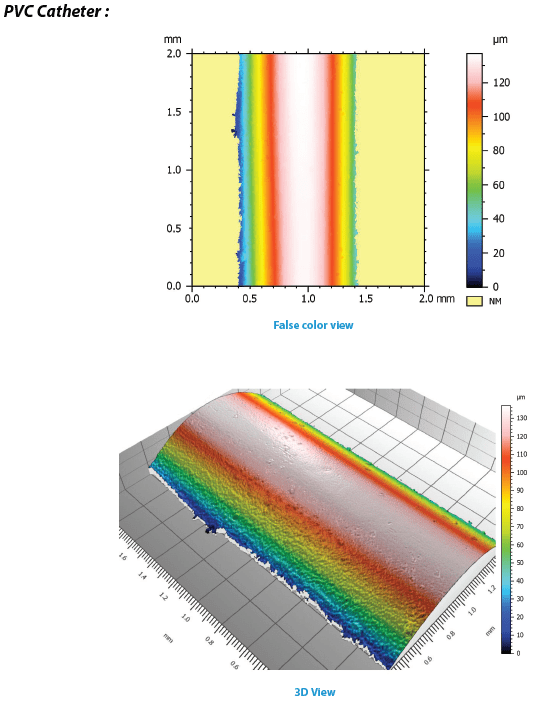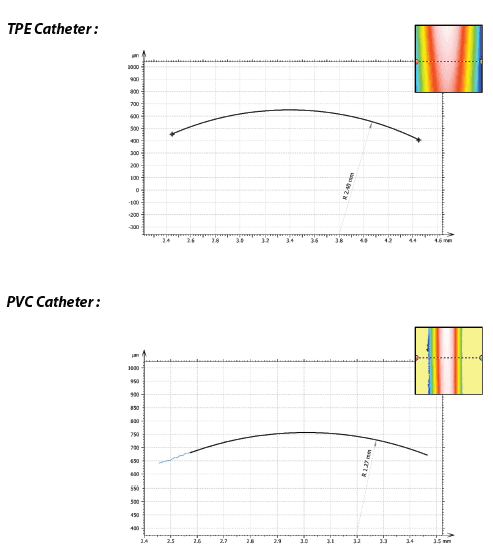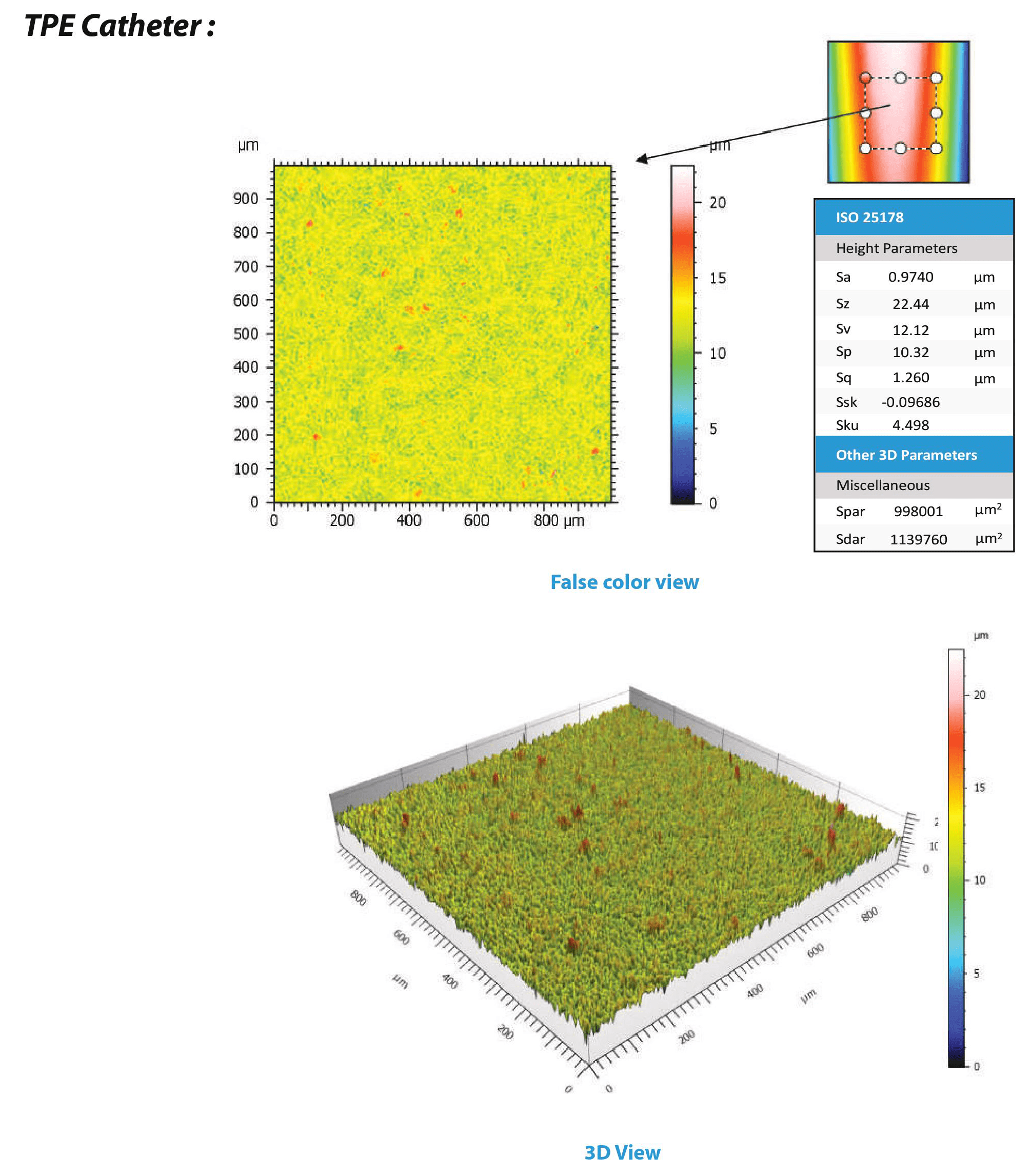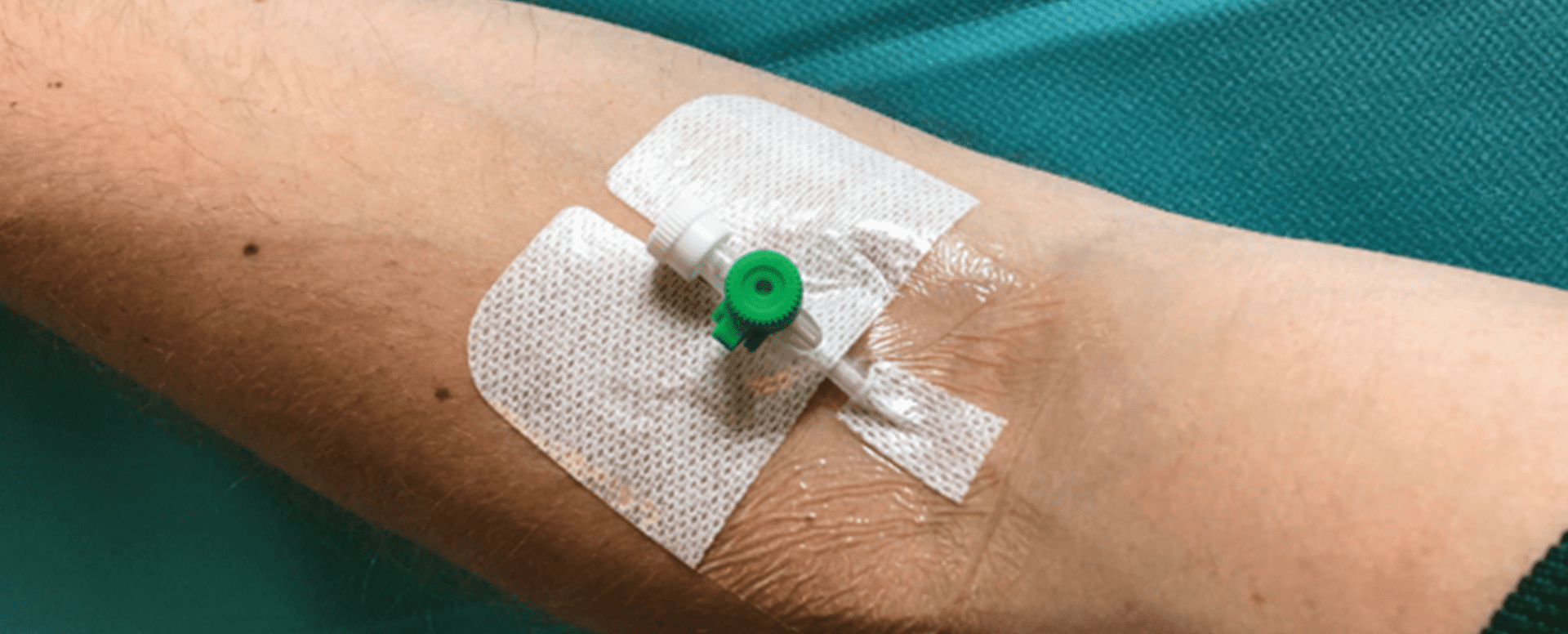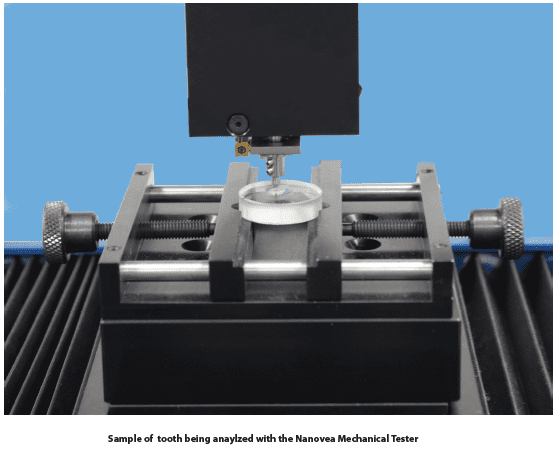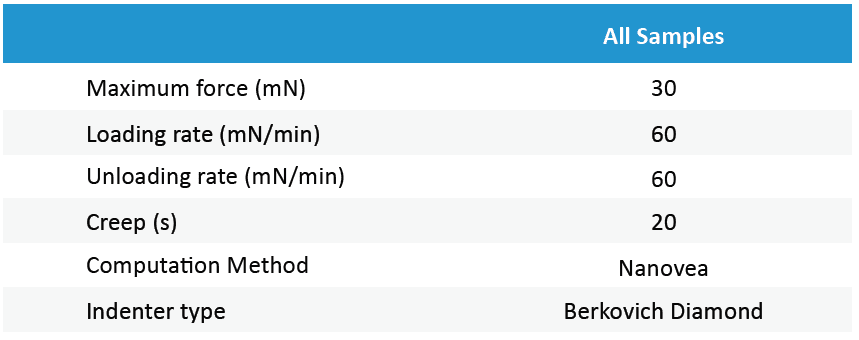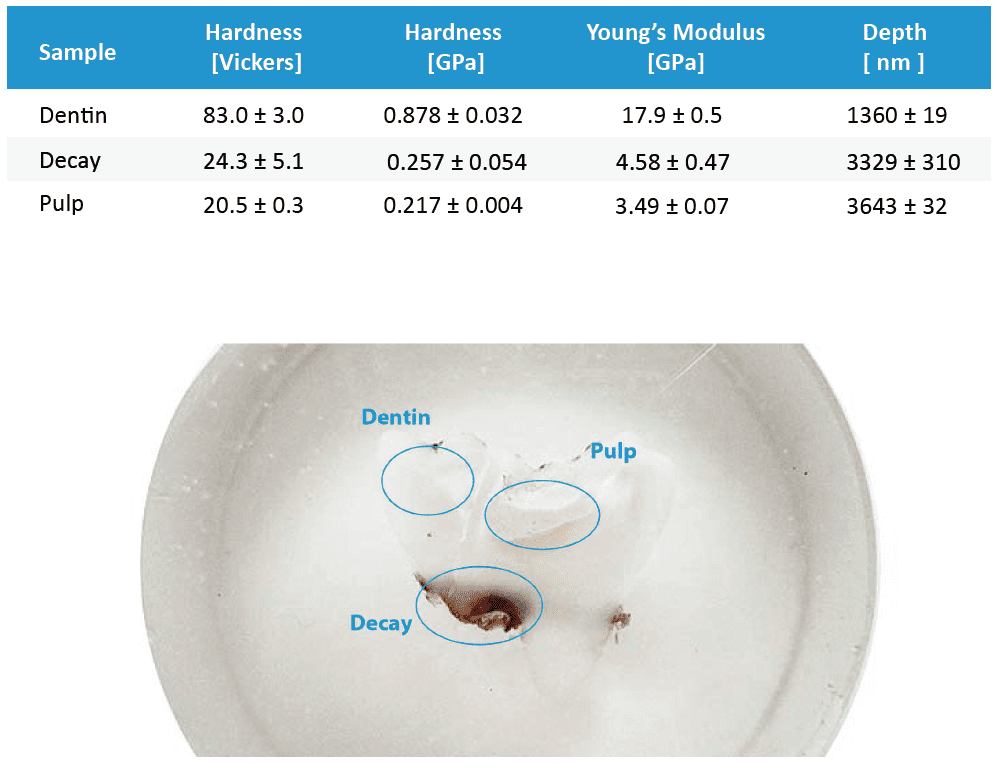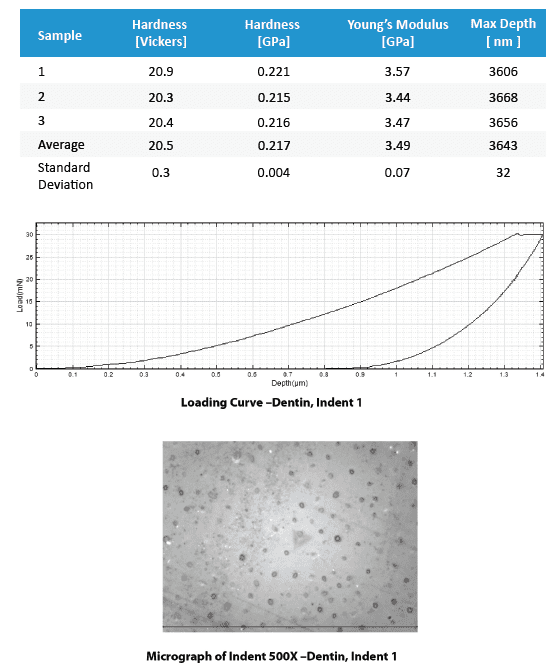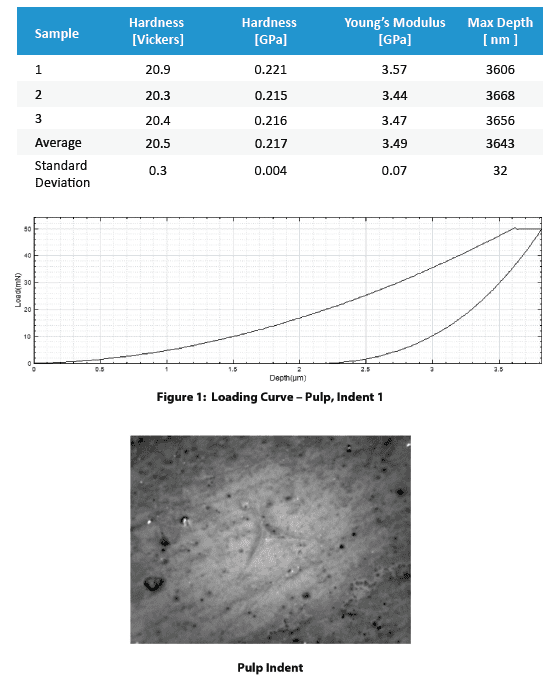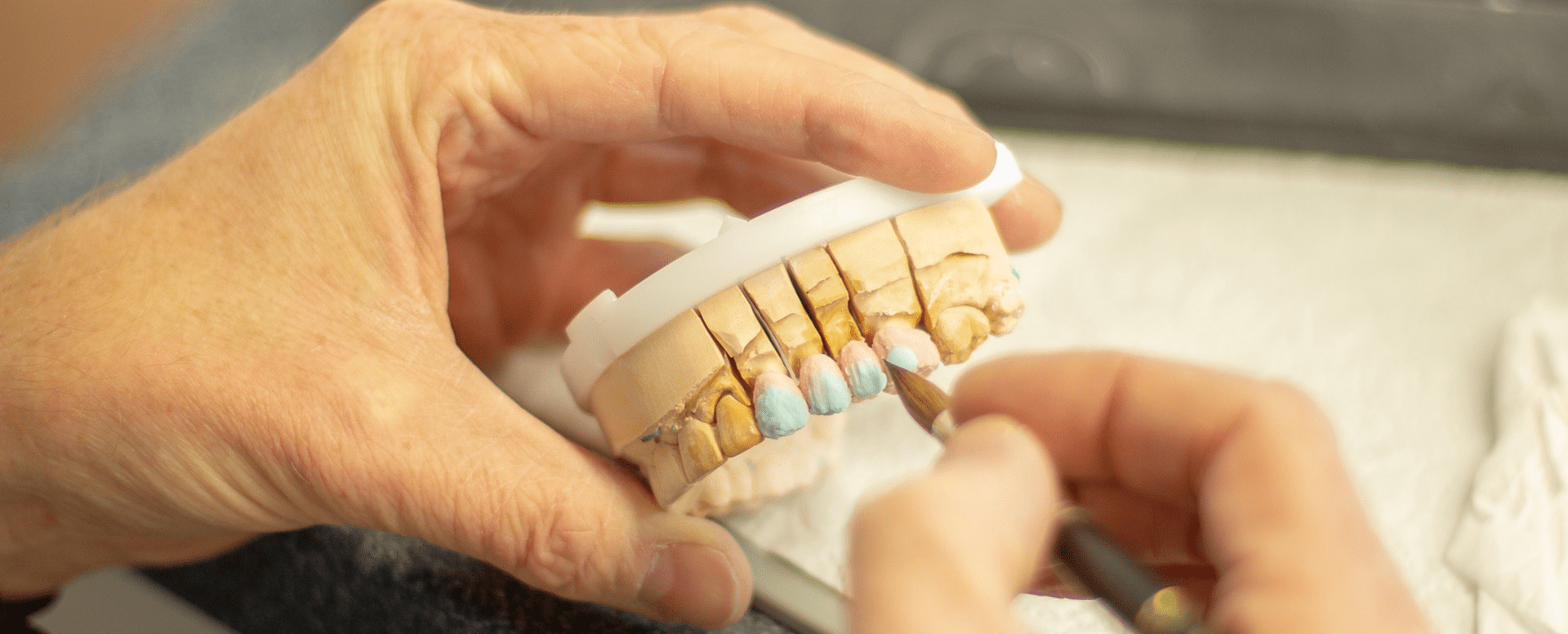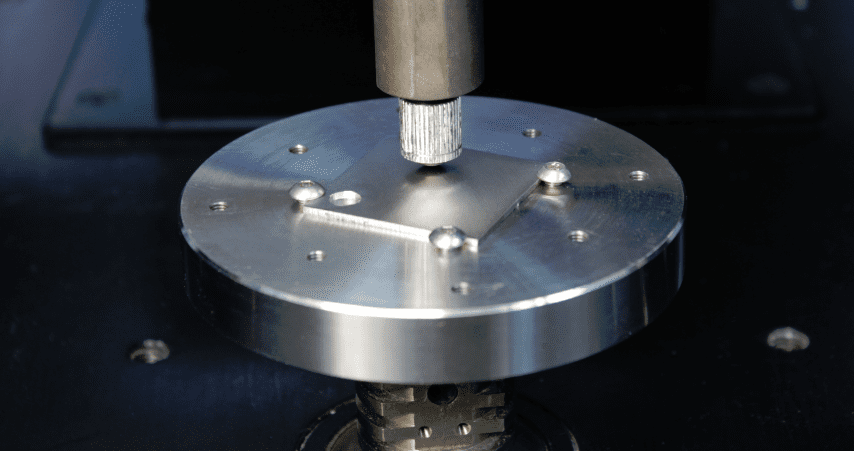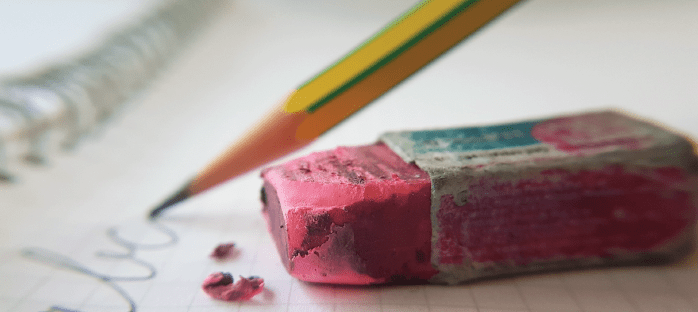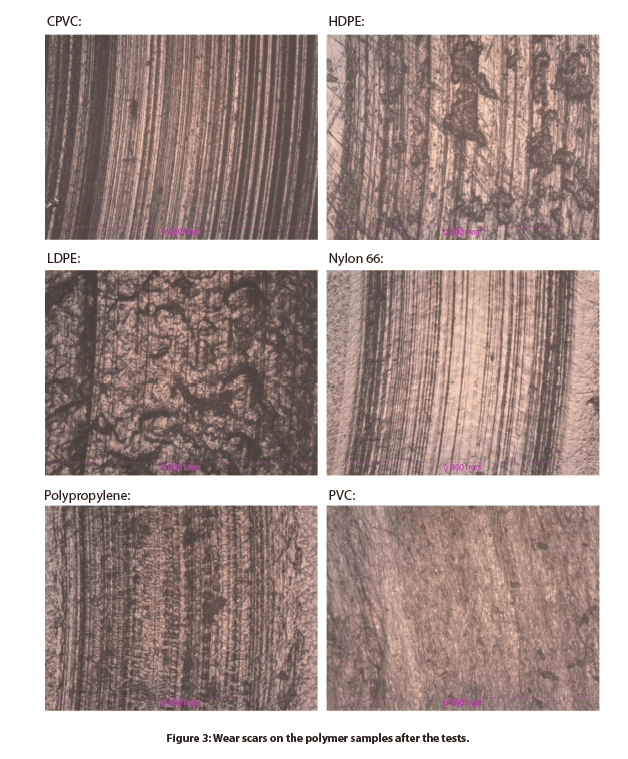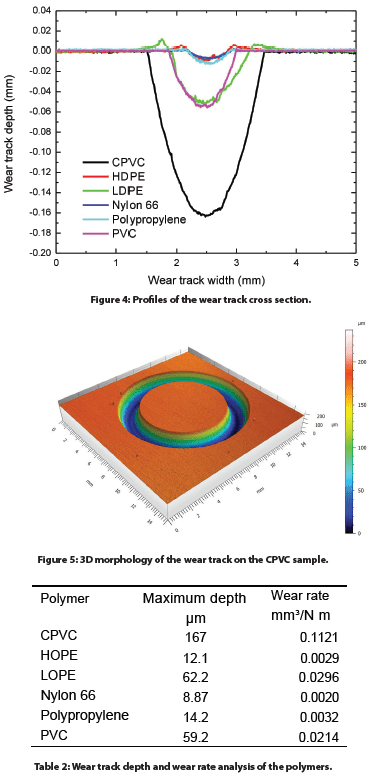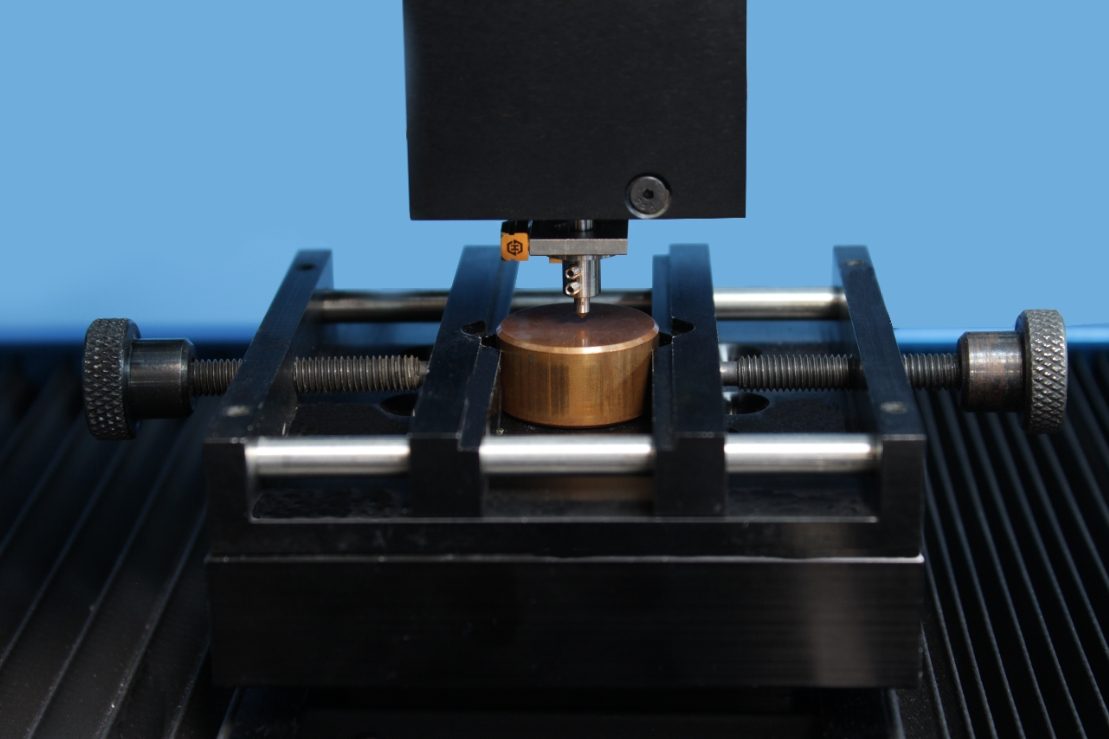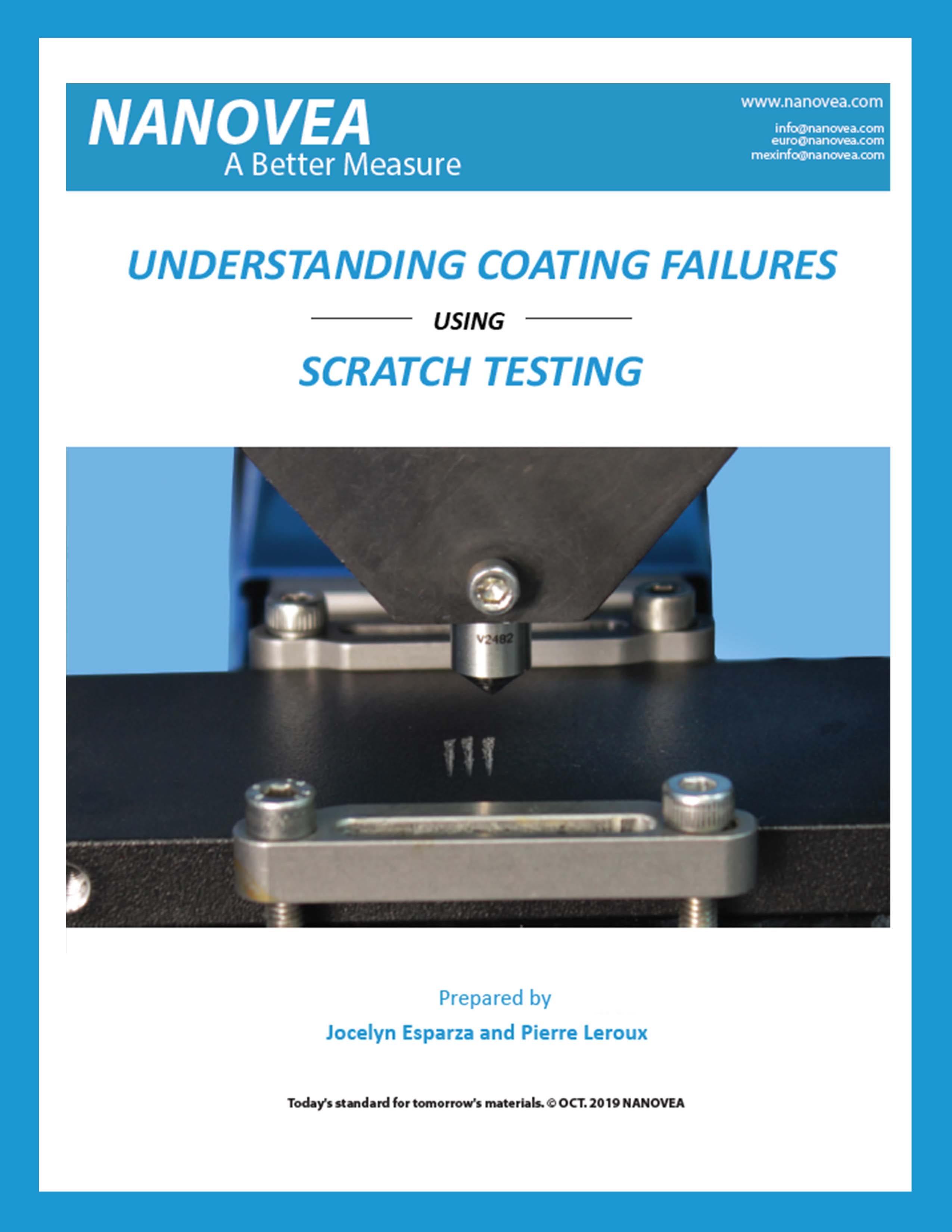Categoría: Notas de aplicación

Efecto de la humedad en la tribología del revestimiento de DLC
Importancia de la evaluación del desgaste del DLC en condiciones de humedad
Los recubrimientos de carbono tipo diamante (DLC) poseen propiedades tribológicas mejoradas, concretamente una excelente resistencia al desgaste y un coeficiente de fricción (COF) muy bajo. Los recubrimientos de DLC imprimen características de diamante cuando se depositan sobre distintos materiales. Las propiedades tribo-mecánicas favorables hacen que los recubrimientos de DLC sean preferibles en diversas aplicaciones industriales, como piezas aeroespaciales, hojas de afeitar, herramientas de corte de metal, cojinetes, motores de motocicletas e implantes médicos.
Los revestimientos de DLC presentan un COF muy bajo (inferior a 0,1) frente a las bolas de acero en condiciones de alto vacío y en seco.12. Sin embargo, los recubrimientos de DLC son sensibles a los cambios de las condiciones ambientales, en particular a la humedad relativa (HR)3. Los entornos con alta humedad y concentración de oxígeno pueden provocar un aumento significativo del COF4. La evaluación fiable del desgaste en condiciones de humedad controlada simula las condiciones ambientales realistas de los revestimientos de DLC para aplicaciones tribológicas. Los usuarios seleccionan los mejores revestimientos de DLC para las aplicaciones deseadas mediante una comparación adecuada.
de los comportamientos de desgaste del DLC expuesto a diferentes humedades.
Objetivo de medición
Este estudio muestra la tecnología Nanovea Tribómetro equipado con un controlador de humedad es la herramienta ideal para investigar el comportamiento de desgaste de los recubrimientos de DLC a distintas humedades relativas.
Procedimiento de ensayo
La resistencia a la fricción y al desgaste de los recubrimientos de DLC se evaluó con el tribómetro Nanovea. Los parámetros de ensayo se resumen en la Tabla 1. Un controlador de humedad acoplado a la tribocámara controló con precisión la humedad relativa (HR) con una exactitud de ±1%. Las huellas de desgaste en los recubrimientos de DLC y las cicatrices de desgaste en las bolas de SiN se examinaron con un microscopio óptico después de las pruebas.
Nota: Se puede aplicar cualquier material de bola sólida para simular el rendimiento de acoplamiento de diferentes materiales en condiciones ambientales como en lubricante o alta temperatura.
Resultados y debate
Los recubrimientos de DLC son excelentes para aplicaciones tribológicas debido a su baja fricción y a su mayor resistencia al desgaste. La fricción del recubrimiento de DLC presenta un comportamiento dependiente de la humedad, como se muestra en la figura 2. El recubrimiento de DLC muestra un COF muy bajo de ~0,05 durante todo el ensayo de desgaste en condiciones relativamente secas (10% HR). El recubrimiento de DLC muestra un COF constante de ~0,1 durante la prueba a medida que la HR aumenta hasta 30%. La fase inicial de rodaje del COF se observa en las primeras 2000 revoluciones cuando la HR aumenta por encima de 50%. El revestimiento de DLC muestra un COF máximo de ~0,20, ~0,26 y ~0,33 en HR de 50, 70 y 90%, respectivamente. Tras el periodo de rodaje, el COF del revestimiento de DLC se mantiene constante en ~0,11, 0,13 y 0,20 con HR de 50, 70 y 90%, respectivamente.
La figura 3 compara las cicatrices de desgaste de las bolas de SiN y la figura 4 compara las huellas de desgaste del recubrimiento de DLC tras las pruebas de desgaste. El diámetro de la cicatriz de desgaste era menor cuando el recubrimiento de DLC se exponía a un entorno con baja humedad. La capa de DLC transferida se acumula en la superficie de la bola de SiN durante el proceso de deslizamiento repetitivo en la superficie de contacto. En esta fase, el recubrimiento de DLC se desliza contra su propia capa de transferencia, que actúa como un lubricante eficaz para facilitar el movimiento relativo y frenar la pérdida de masa adicional causada por la deformación por cizallamiento. Se observa una película de transferencia en la cicatriz de desgaste de la bola de SiN en entornos de baja HR (por ejemplo, 10% y 30%), lo que da lugar a un proceso de desgaste desacelerado de la bola. Este proceso de desgaste se refleja en la morfología de la pista de desgaste del recubrimiento de DLC, como se muestra en la figura 4. El recubrimiento de DLC muestra una pista de desgaste más pequeña en ambientes secos, debido a la formación de una película de transferencia de DLC estable en la interfaz de contacto que reduce significativamente la fricción y la tasa de desgaste.
Conclusión
La humedad desempeña un papel fundamental en el rendimiento tribológico de los recubrimientos de DLC. El recubrimiento de DLC posee una resistencia al desgaste significativamente mejorada y una baja fricción superior en condiciones secas debido a la formación de una capa grafítica estable transferida a la contraparte deslizante (una bola de SiN en este estudio). El recubrimiento de DLC se desliza contra su propia capa de transferencia, que actúa como un lubricante eficaz para facilitar el movimiento relativo y frenar la pérdida de masa adicional causada por la deformación por cizallamiento. No se observa una película en la bola de SiN con el aumento de la humedad relativa, lo que conduce a un aumento de la tasa de desgaste en la bola de SiN y el recubrimiento de DLC.
El tribómetro Nanovea ofrece pruebas repetibles de desgaste y fricción mediante modos rotativos y lineales conformes a las normas ISO y ASTM, con módulos opcionales de humedad disponibles en un sistema preintegrado. Permite a los usuarios simular el entorno de trabajo a diferentes humedades, proporcionando a los usuarios una herramienta ideal para evaluar cuantitativamente los comportamientos tribológicos de los materiales en diferentes condiciones de trabajo.
Más información sobre el tribómetro Nanovea y el servicio de laboratorio
1 C. Donnet, Surf. Coat. Technol. 100-101 (1998) 180.
2 K. Miyoshi, B. Pohlchuck, K.W. Street, J.S. Zabinski, J.H. Sanders, A.A. Voevodin, R.L.C. Wu, Wear 225-229 (1999) 65.- K. Miyoshi.
3 R. Gilmore, R. Hauert, Surf. Coat. Technol. 133-134 (2000) 437.
4 R. Memming, H.J. Tolle, P.E. Wierenga, Thin Solid Coatings 143 (1986) 31
AHORA, HABLEMOS DE SU SOLICITUD

Análisis tridimensional de la superficie de una moneda con perfilometría sin contacto
Importancia de la perfilometría sin contacto para monedas
La moneda tiene un gran valor en la sociedad moderna porque se intercambia por bienes y servicios. Las monedas y billetes circulan por las manos de muchas personas. La transferencia constante de moneda física crea deformaciones en la superficie. Nanovea 3D Perfilómetro escanea la topografía de monedas acuñadas en distintos años para investigar las diferencias de superficie.
Las características de las monedas son fácilmente reconocibles para el público en general, ya que son objetos comunes. Una moneda de un céntimo es ideal para presentar la potencia del software de análisis avanzado de superficies de Nanovea: Montañas 3D. Los datos de superficie recogidos con nuestro Perfilómetro 3D permiten realizar análisis de alto nivel en geometría compleja con sustracción de superficies y extracción de contornos 2D. La sustracción de superficies con una máscara, un sello o un molde controlados compara la calidad de los procesos de fabricación, mientras que la extracción de contornos identifica las tolerancias con un análisis dimensional. El perfilómetro 3D de Nanovea y el software Mountains 3D investigan la topografía submicrónica de objetos aparentemente sencillos, como los céntimos.
Objetivo de medición
Se escaneó toda la superficie superior de cinco peniques utilizando el sensor de líneas de alta velocidad de Nanovea. El radio interior y exterior de cada penique se midió con el software de análisis avanzado Mountains. Una extracción de la superficie de cada penique en un área de interés con sustracción directa de la superficie cuantificó la deformación de la superficie.
Resultados y debate
Superficie 3D
El perfilómetro Nanovea HS2000 tardó sólo 24 segundos en escanear 4 millones de puntos en un área de 20 mm x 20 mm con un tamaño de paso de 10um x 10um para adquirir la superficie de un céntimo. A continuación se muestra un mapa de alturas y una visualización en 3D del escaneado. La vista en 3D muestra la capacidad del sensor de alta velocidad para captar pequeños detalles imperceptibles a simple vista. En la superficie de la moneda de un céntimo se aprecian muchos pequeños arañazos. Se investigan la textura y la rugosidad de la moneda vistas en la vista 3D.
Se extrajeron los contornos del centavo y mediante un análisis dimensional se obtuvieron los diámetros interior y exterior de la característica del borde. La media del radio exterior fue de 9,500 mm ± 0,024, mientras que la media del radio interior fue de 8,960 mm ± 0,032. Otros análisis dimensionales que Mountains 3D puede realizar en fuentes de datos 2D y 3D son la medición de distancias, la altura de los escalones, la planitud y el cálculo de ángulos.
La figura 5 muestra el área de interés para el análisis de sustracción de superficie. El penique de 2007 se utilizó como superficie de referencia para los cuatro peniques más antiguos. La sustracción de la superficie del penique de 2007 muestra las diferencias entre los peniques con agujeros/picos. La diferencia de volumen total de la superficie se obtiene sumando los volúmenes de los agujeros/picos. El error cuadrático medio indica la concordancia entre las superficies de los céntimos.
Conclusión

El escáner de alta velocidad HS2000L de Nanovea escaneó cinco monedas de un penique acuñadas en diferentes años. El software Mountains 3D comparó las superficies de cada moneda mediante extracción de contornos, análisis dimensional y sustracción de superficies. El análisis define claramente los radios interior y exterior entre los peniques, a la vez que compara directamente las diferencias de las características superficiales. Con la capacidad del perfilómetro 3D de Nanovea para medir cualquier superficie con una resolución nanométrica, combinada con las capacidades de análisis de Mountains 3D, las posibles aplicaciones de investigación y control de calidad son infinitas.
AHORA, HABLEMOS DE SU SOLICITUD

Acabado dimensional y superficial de los tubos poliméricos
Importancia del análisis dimensional y superficial de los tubos poliméricos
Los tubos fabricados con material polimérico se utilizan comúnmente en muchas industrias que van desde la automoción, la medicina, la electricidad y muchas otras categorías. En este estudio, se estudiaron catéteres médicos fabricados con distintos materiales poliméricos utilizando el Nanovea Perfilómetro 3D sin contacto para medir la rugosidad, la morfología y las dimensiones de la superficie. La rugosidad de la superficie es crucial para los catéteres, ya que muchos de sus problemas, como las infecciones, los traumatismos físicos y las inflamaciones, pueden estar relacionados con la superficie del catéter. Las propiedades mecánicas, como el coeficiente de fricción, también pueden estudiarse observando las propiedades de la superficie. Estos datos cuantificables pueden obtenerse para garantizar que el catéter pueda utilizarse en aplicaciones médicas.
En comparación con la microscopía óptica y la microscopía electrónica, la perfilometría 3D sin contacto mediante cromatismo axial es muy preferible para caracterizar las superficies de los catéteres debido a su capacidad para medir ángulos/curvaturas, su capacidad para medir superficies de materiales a pesar de su transparencia o reflectividad, la preparación mínima de la muestra y su naturaleza no invasiva. A diferencia de la microscopía óptica convencional, la altura de la superficie puede obtenerse y utilizarse para el análisis computacional; por ejemplo, encontrar las dimensiones y eliminar la forma para encontrar la rugosidad de la superficie. La escasa preparación de la muestra, a diferencia de la microscopía electrónica, y la naturaleza sin contacto también permiten obtener datos rápidamente sin temer la contaminación y los errores derivados de la preparación de la muestra.
Objetivo de medición
En esta aplicación, el perfilómetro sin contacto 3D Nanovea se utiliza para escanear la superficie de dos catéteres: uno de TPE (elastómero termoplástico) y otro de PVC (cloruro de polivinilo). Se obtendrán y compararán los parámetros de morfología, dimensión radial y altura de los dos catéteres.
Resultados y debate
Superficie 3D
A pesar de la curvatura de los tubos poliméricos, el perfilómetro sin contacto Nanovea 3D puede escanear la superficie de los catéteres. A partir del escaneado realizado, se puede obtener una imagen 3D para una inspección visual rápida y directa de la superficie.
La dimensión radial exterior se obtuvo extrayendo un perfil del escaneado original y ajustando un arco al perfil. Esto demuestra la capacidad del perfilómetro 3D sin contacto para realizar análisis dimensionales rápidos en aplicaciones de control de calidad. También pueden obtenerse fácilmente múltiples perfiles a lo largo de la longitud del catéter.
La dimensión radial exterior se obtuvo extrayendo un perfil del escaneado original y ajustando un arco al perfil. Esto demuestra la capacidad del perfilómetro 3D sin contacto para realizar análisis dimensionales rápidos en aplicaciones de control de calidad. También pueden obtenerse fácilmente múltiples perfiles a lo largo de la longitud del catéter.
Conclusión
En esta aplicación, hemos mostrado cómo puede utilizarse el perfilómetro sin contacto Nanovea 3D para caracterizar tubos poliméricos. En concreto, se obtuvieron la metrología superficial, las dimensiones radiales y la rugosidad superficial de catéteres médicos. Se comprobó que el radio exterior del catéter de TPE era de 2,40 mm, mientras que el del catéter de PVC era de 1,27 mm. La superficie del catéter de TPE era más rugosa que la del catéter de PVC. La Sa del TPE era de 0,9740µm en comparación con 0,1791µm del PVC. Aunque para esta aplicación se utilizaron catéteres médicos, la perfilometría 3D sin contacto puede aplicarse también a una gran variedad de superficies. Los datos y cálculos que se pueden obtener no se limitan a lo que se muestra.
AHORA, HABLEMOS DE SU SOLICITUD
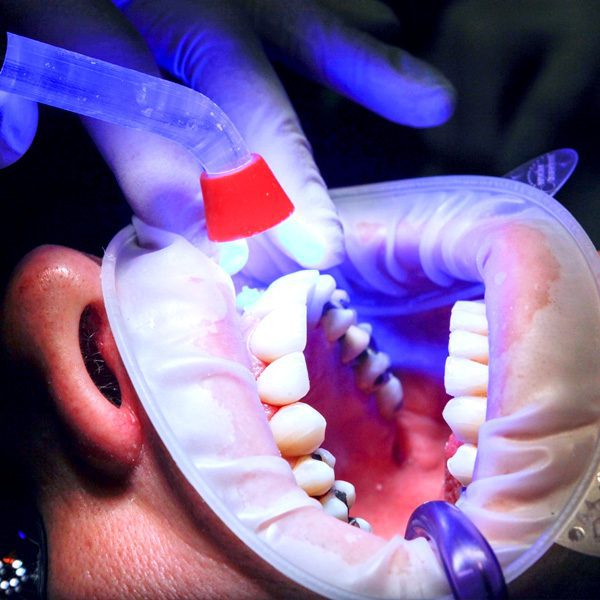
Evaluación de la dureza de los dientes mediante nanoindentación
Importancia de la nanoindentación para los biomateriales
Con muchos ensayos mecánicos tradicionales (dureza, adherencia, compresión, punción, límite elástico, etc.), los entornos actuales de control de calidad con materiales sensibles avanzados, desde geles hasta materiales quebradizos, requieren ahora un control de mayor precisión y fiabilidad. La instrumentación mecánica tradicional no proporciona el control de carga sensible y la resolución requerida; está diseñada para utilizarse con materiales a granel. A medida que aumentaba el interés por el tamaño del material sometido a ensayo, surgió el desarrollo de Nanoindentación han proporcionado un método fiable para obtener información mecánica esencial en superficies más pequeñas, como la investigación que se realiza con biomateriales. Los retos específicamente asociados a los biomateriales han exigido el desarrollo de ensayos mecánicos capaces de controlar con precisión la carga en materiales extremadamente blandos a quebradizos. Además, se necesitan varios instrumentos para realizar diversas pruebas mecánicas que ahora pueden realizarse en un único sistema. La nanoindentación ofrece una amplia gama de mediciones con una resolución precisa en cargas nanocontroladas para aplicaciones sensibles.
Objetivo de medición
En esta aplicación, el Nanovea Comprobador mecánicoen modo de nanoindentación, se utiliza para estudiar la dureza y el módulo elástico de la dentina, la caries y la pulpa de un diente. El aspecto más crítico de los ensayos de nanoindentación es la fijación de la muestra; en este caso tomamos un diente cortado y lo montamos con epoxi, dejando las tres zonas de interés expuestas para el ensayo.
Resultados y debate
Esta sección incluye una tabla resumen que compara los principales resultados numéricos de las distintas muestras, seguida de los listados de resultados completos, que incluyen cada indentación realizada, acompañados de micrografías de la indentación, cuando están disponibles. Estos resultados completos presentan los valores medidos de dureza y módulo de Young como la profundidad de penetración con sus medias y desviaciones estándar. Debe tenerse en cuenta que pueden producirse grandes variaciones en los resultados en el caso de que la rugosidad de la superficie se encuentre en el mismo intervalo de tamaño que la indentación.
Tabla resumen de los principales resultados numéricos:
Conclusión
En conclusión, hemos mostrado cómo el Nanovea Mechanical Tester, en modo de nanoindentación, proporciona una medición precisa de las propiedades mecánicas de un diente. Los datos pueden utilizarse en el desarrollo de obturaciones que se ajusten mejor a las características mecánicas de un diente real. La capacidad de posicionamiento del Nanovea Mechanical Tester permite obtener un mapa completo de la dureza de los dientes en las distintas zonas.
Utilizando el mismo sistema, es posible probar la tenacidad a la fractura del material de los dientes con cargas más elevadas, de hasta 200N. Se puede utilizar un ensayo de carga de varios ciclos en materiales más porosos para evaluar el nivel de elasticidad restante. El uso de una punta de diamante cilíndrica plana puede proporcionar información sobre el límite elástico en cada zona. Además, con DMA "Análisis Mecánico Dinámico", pueden evaluarse las propiedades viscoelásticas, incluidos los módulos de pérdida y almacenamiento.
El nanomódulo Nanovea es ideal para estas pruebas porque utiliza una respuesta de retroalimentación única para controlar con precisión la carga aplicada. Gracias a ello, el nano módulo también puede utilizarse para realizar ensayos precisos de nano rayado. El estudio de la resistencia al rayado y al desgaste del material dental y de los materiales de obturación se suma a la utilidad general del comprobador mecánico. El uso de una punta afilada de 2 micras para comparar cuantitativamente las marcas en los materiales de obturación permitirá predecir mejor el comportamiento en aplicaciones reales. Las pruebas de desgaste multipaso o de desgaste rotativo directo también son pruebas habituales que proporcionan información importante sobre la viabilidad a largo plazo.
AHORA, HABLEMOS DE SU SOLICITUD

Evaluación de la fricción a velocidades extremadamente bajas
Importancia de la evaluación de la fricción a baja velocidad
La fricción es la fuerza que resiste el movimiento relativo de superficies sólidas que se deslizan una contra otra. Cuando se produce el movimiento relativo de estas dos superficies en contacto, la fricción en la interfaz convierte la energía cinética en calor. Este proceso también puede provocar el desgaste del material y, por tanto, la degradación del rendimiento de las piezas en uso.
Con un gran índice de elasticidad, alta resiliencia, así como grandes propiedades impermeables y resistencia al desgaste, el caucho se utiliza ampliamente en una gran variedad de aplicaciones y productos en los que la fricción desempeña un papel importante, como neumáticos de automóviles, escobillas limpiaparabrisas, suelas de zapatos y muchos otros. Dependiendo de la naturaleza y los requisitos de estas aplicaciones, se desea una fricción alta o baja contra distintos materiales. En consecuencia, resulta fundamental una medición controlada y fiable de la fricción del caucho contra diversas superficies.
Objetivo de medición
El coeficiente de fricción (COF) del caucho contra diferentes materiales se mide de forma controlada y monitorizada utilizando el Nanovea Tribómetro. En este estudio, nos gustaría mostrar la capacidad del Tribómetro Nanovea para medir el COF de diferentes materiales a velocidades extremadamente bajas.
Resultados y debate
El coeficiente de fricción (COF) de las bolas de caucho (6 mm de diámetro, RubberMill) sobre tres materiales (acero inoxidable SS 316, Cu 110 y acrílico opcional) se evaluó mediante el tribómetro Nanovea. Las muestras metálicas sometidas a ensayo se pulieron mecánicamente hasta obtener un acabado superficial similar al de un espejo antes de la medición. La ligera deformación de la bola de goma bajo la carga normal aplicada creó un área de contacto, que también ayuda a reducir el impacto de las asperezas o la falta de homogeneidad del acabado de la superficie de la muestra en las mediciones del COF. Los parámetros de ensayo se resumen en la Tabla 1.
En la figura se muestra el COF de una pelota de caucho contra distintos materiales a cuatro velocidades diferentes. 2, y en la figura 3 se resumen y comparan los COF medios calculados automáticamente por el software. Es interesante observar que las muestras metálicas (SS 316 y Cu 110) presentan un aumento significativo del COF a medida que aumenta la velocidad de rotación desde un valor muy bajo de 0,01 rpm hasta 5 rpm: el valor del COF de la pareja caucho/SS 316 aumenta de 0,29 a 0,8, y de 0,65 a 1,1 para la pareja caucho/Cu 110. Este hallazgo concuerda con los resultados obtenidos para la pareja caucho/SS 316. Esta constatación coincide con los resultados comunicados por varios laboratorios. Como propone Grosch4 la fricción del caucho viene determinada principalmente por dos mecanismos: (1) la adherencia entre el caucho y el otro material, y (2) las pérdidas de energía debidas a la deformación del caucho causada por las asperezas de la superficie. Schallamach5 observaron ondas de desprendimiento del caucho del contramaterial a través de la interfaz entre esferas de caucho blando y una superficie dura. La fuerza que ejerce el caucho para desprenderse de la superficie del sustrato y la velocidad de las ondas de desprendimiento pueden explicar la diferente fricción a diferentes velocidades durante la prueba.
En comparación, la pareja caucho/material acrílico presenta un COF elevado a diferentes velocidades de rotación. El valor del COF aumenta ligeramente de ~ 1,02 a ~ 1,09 a medida que aumenta la velocidad de rotación de 0,01 rpm a 5 rpm. Este elevado COF se atribuye posiblemente a una unión química local más fuerte en la cara de contacto formada durante las pruebas.
Conclusión
En este estudio, demostramos que a velocidades extremadamente bajas, el caucho muestra un comportamiento friccional peculiar - su fricción contra una superficie dura aumenta con el incremento de la velocidad del movimiento relativo. El caucho muestra una fricción diferente cuando se desliza sobre distintos materiales. El tribómetro Nanovea puede evaluar las propiedades de fricción de los materiales de forma controlada y monitorizada a diferentes velocidades, lo que permite a los usuarios mejorar la comprensión fundamental del mecanismo de fricción de los materiales y seleccionar la mejor pareja de materiales para aplicaciones de ingeniería tribológica específicas.
El tribómetro Nanovea ofrece pruebas de desgaste y fricción precisas y repetibles mediante modos rotativos y lineales conformes a las normas ISO y ASTM, con módulos opcionales de desgaste a alta temperatura, lubricación y tribo-corrosión disponibles en un sistema preintegrado. Es capaz de controlar la etapa rotativa a velocidades extremadamente bajas, de hasta 0,01 rpm, y monitorizar la evolución de la fricción in situ. La gama inigualable de Nanovea es una solución ideal para determinar toda la gama de propiedades tribológicas de revestimientos, películas y sustratos finos o gruesos, blandos o duros.
AHORA, HABLEMOS DE SU SOLICITUD
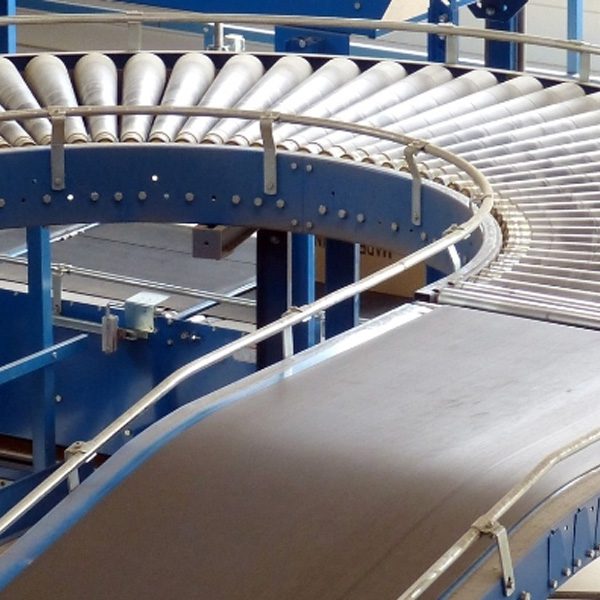
Tribología de polímeros
Introducción
Los polímeros se han utilizado ampliamente en una gran variedad de aplicaciones y se han convertido en una parte indispensable de la vida cotidiana. Polímeros naturales como el ámbar, la seda y el caucho natural han desempeñado un papel esencial en la historia de la humanidad. El proceso de fabricación de polímeros sintéticos puede optimizarse para conseguir propiedades físicas únicas, como tenacidad, viscoelasticidad, autolubricación y muchas otras.
Importancia del desgaste y la fricción de los polímeros
Los polímeros se utilizan habitualmente en aplicaciones tribológicas, como neumáticos, rodamientos y cintas transportadoras.
Se producen diferentes mecanismos de desgaste en función de las propiedades mecánicas del polímero, las condiciones de contacto y las propiedades de los residuos o de la película de transferencia formada durante el proceso de desgaste. Para garantizar que los polímeros poseen suficiente resistencia al desgaste en las condiciones de servicio, es necesaria una evaluación tribológica fiable y cuantificable. La evaluación tribológica nos permite comparar cuantitativamente los comportamientos de desgaste de diferentes polímeros de forma controlada y monitorizada para seleccionar el material candidato para la aplicación objetivo.
El tribómetro Nanovea ofrece pruebas repetibles de desgaste y fricción mediante modos rotativos y lineales conformes a las normas ISO y ASTM, con módulos opcionales de desgaste y lubricación a alta temperatura disponibles en un sistema preintegrado. Esta gama inigualable permite a los usuarios simular los diferentes entornos de trabajo de los polímeros, incluyendo tensión concentrada, desgaste y alta temperatura, etc.
OBJETIVO DE MEDICIÓN
En este estudio, demostramos que el Nanovea Tribómetro es una herramienta ideal para comparar la resistencia a la fricción y al desgaste de diferentes polímeros de forma cuantitativa y bien controlada.
PROCEDIMIENTO DE PRUEBA
El coeficiente de fricción (COF) y la resistencia al desgaste de diferentes polímeros comunes se evaluaron mediante el tribómetro Nanovea. Se utilizó una bola de Al2O3 como contramaterial (perno, muestra estática). Las huellas de desgaste en los polímeros (muestras dinámicas giratorias) se midieron utilizando un perfilómetro 3D sin contacto y microscopio óptico una vez concluidas las pruebas. Cabe señalar que, opcionalmente, se puede utilizar un sensor endoscópico sin contacto para medir la profundidad a la que el pasador penetra en la muestra dinámica durante una prueba de desgaste. Los parámetros de la prueba se resumen en la Tabla 1. La tasa de desgaste, K, se evaluó mediante la fórmula K=Vl(Fxs), donde V es el volumen desgastado, F es la carga normal y s es la distancia de deslizamiento.
Tenga en cuenta que en este estudio se utilizaron bolas de Al2O3 como contramaterial. Puede sustituirse por cualquier material sólido para simular mejor el comportamiento de dos muestras en condiciones de aplicación reales.
RESULTADOS Y DEBATE
La velocidad de desgaste es un factor vital para determinar la vida útil de los materiales, mientras que la fricción desempeña un papel crítico durante las aplicaciones tribológicas. La figura 2 compara la evolución del COF de diferentes polímeros frente a la bola de Al2O3 durante las pruebas de desgaste. El COF funciona como indicador de cuándo se producen los fallos y el proceso de desgaste entra en una nueva etapa. Entre los polímeros ensayados, el HDPE mantiene el COF constante más bajo de ~0,15 durante todo el ensayo de desgaste. La suavidad del COF implica que se forma un tribo-contacto estable.
En las figuras 3 y 4 se comparan las huellas de desgaste de las muestras de polímero tras la prueba medida con el microscopio óptico. El perfilómetro 3D sin contacto in situ determina con precisión el volumen de desgaste de las muestras de polímero, lo que permite calcular con exactitud índices de desgaste de 0,0029, 0,0020 y 0,0032m3/N m, respectivamente. En comparación, la muestra de CPVC muestra el mayor índice de desgaste de 0,1121m3/N m. En la huella de desgaste del CPVC se observan profundas cicatrices de desgaste paralelas.
CONCLUSIÓN
La resistencia al desgaste de los polímeros desempeña un papel vital en su rendimiento de servicio. En este estudio, demostramos que el tribómetro Nanovea evalúa el coeficiente de fricción y la tasa de desgaste de diferentes polímeros en un...
de forma cuantitativa y bien controlada. El HDPE muestra el COF más bajo de ~0,15 entre los polímeros ensayados. Las muestras de HDPE, Nylon 66 y Polipropileno poseen bajos índices de desgaste de 0,0029, 0,0020 y 0,0032 m3/N m, respectivamente. La combinación de baja fricción y gran resistencia al desgaste hace del HDPE un buen candidato para aplicaciones tribológicas de polímeros.
El perfilómetro 3D in situ y sin contacto permite medir con precisión el volumen de desgaste y ofrece una herramienta para analizar la morfología detallada de las huellas de desgaste, lo que permite comprender mejor los mecanismos fundamentales del desgaste.
AHORA, HABLEMOS DE SU SOLICITUD

Acabado superficial de paneles alveolares con perfilometría 3D
INTRODUCCIÓN
La rugosidad, la porosidad y la textura de la superficie de los paneles alveolares son factores críticos que hay que cuantificar para el diseño final del panel. Estas cualidades de la superficie pueden correlacionarse directamente con la estética y las características funcionales de la superficie del panel. Un mejor conocimiento de la textura y la porosidad de la superficie puede ayudar a optimizar el procesamiento y la fabricabilidad de la superficie del panel. Se necesita una medición cuantitativa, precisa y fiable de la superficie del panel alveolar para controlar los parámetros de superficie para los requisitos de aplicación y pintura. Los sensores sin contacto Nanovea 3D utilizan una tecnología confocal cromática única capaz de medir con precisión las superficies de estos paneles.
OBJETIVO DE MEDICIÓN
En este estudio, se utilizó la plataforma Nanovea HS2000 equipada con un sensor de línea de alta velocidad para medir y comparar dos paneles de nido de abeja con diferentes acabados superficiales. Mostramos la plataforma Nanovea perfilómetro sin contactopara proporcionar mediciones de perfilado 3D rápidas y precisas y un análisis exhaustivo en profundidad del acabado de la superficie.
RESULTADOS Y DEBATE
Se midió la superficie de dos muestras de paneles alveolares con distintos acabados superficiales, a saber, la Muestra 1 y la Muestra 2. El falso color y la vista en 3D de las superficies de las Muestras 1 y 2 se muestran en la Figura 3 y la Figura 4, respectivamente. Los valores de rugosidad y planitud se calcularon mediante un software de análisis avanzado y se comparan en la Tabla 1. La Muestra 2 exhibe una superficie más porosa en comparación con la Muestra 1. Como resultado, la Muestra 2 posee una mayor rugosidad Sa de 14,7 µm, en comparación con un valor Sa de 4,27 µm para la Muestra 1.
Los perfiles 2D de las superficies de los paneles alveolares se compararon en la figura 5, lo que permite a los usuarios tener una comparación visual del cambio de altura en diferentes lugares de la superficie de la muestra. Podemos observar que la Muestra 1 tiene una variación de altura de ~25 µm entre la ubicación del pico más alto y el valle más bajo. Por otro lado, la Muestra 2 muestra varios poros profundos a lo largo del perfil 2D. El software de análisis avanzado tiene la capacidad de localizar y medir automáticamente la profundidad de seis poros relativamente profundos como se muestra en la tabla de la Figura 4.b Muestra 2. El poro más profundo de los seis posee una profundidad máxima de casi 90 µm (Paso 4).
Para investigar más a fondo el tamaño y la distribución de los poros de la Muestra 2, se realizó una evaluación de la porosidad, que se discute en la sección siguiente. En la Figura 5 se muestra la vista en corte y en la Tabla 2 se resumen los resultados. Podemos observar que los poros, marcados en color azul en la Figura 5, tienen una distribución relativamente homogénea en la superficie de la muestra. El área proyectada de los poros constituye 18,9% de toda la superficie de la muestra. El volumen por mm² del total de poros es de ~0,06 mm³. Los poros tienen una profundidad media de 42,2 µm, y la profundidad máxima es de 108,1 µm.
CONCLUSIÓN
En esta aplicación, hemos demostrado que la plataforma Nanovea HS2000 equipada con un sensor de línea de alta velocidad es una herramienta ideal para analizar y comparar el acabado superficial de muestras de paneles alveolares de forma rápida y precisa. Los escaneados de perfilometría de alta resolución, junto con un software de análisis avanzado, permiten una evaluación exhaustiva y cuantitativa del acabado superficial de las muestras de paneles alveolares.
Los datos mostrados aquí representan sólo una pequeña parte de los cálculos disponibles en el software de análisis. Los perfilómetros Nanovea miden prácticamente cualquier superficie para una amplia gama de aplicaciones en los sectores de semiconductores, microelectrónica, solar, fibra óptica, automoción, aeroespacial, metalurgia, mecanizado, revestimientos, farmacéutico, biomédico, medioambiental y muchos otros.
AHORA, HABLEMOS DE SU SOLICITUD

Medición de la relajación de tensiones mediante nanoindentación
INTRODUCCIÓN
Los materiales viscoelásticos se caracterizan por tener propiedades tanto viscosas como elásticas. Estos materiales están sujetos a una disminución de la tensión dependiente del tiempo (relajación de la tensión) bajo una deformación constante, lo que provoca una pérdida significativa de la fuerza de contacto inicial. La relajación de tensiones depende del tipo de material, la textura, la temperatura, la tensión inicial y el tiempo. Comprender la relajación de tensiones es fundamental para seleccionar materiales óptimos que tengan la resistencia y la flexibilidad (relajación) necesarias para aplicaciones específicas.
Importancia de la medición de la relajación del estrés
Según la norma ASTM E328i, "Standard Test Methods for Stress Relaxation for Materials and Structures", inicialmente se aplica una fuerza externa sobre un material o estructura con un indentador hasta alcanzar una fuerza máxima predeterminada. Una vez alcanzada la fuerza máxima, la posición del penetrador se mantiene constante a esta profundidad. A continuación, se mide la variación de la fuerza externa necesaria para mantener la posición del penetrador en función del tiempo. La dificultad de los ensayos de relajación de tensiones estriba en mantener constante la profundidad. El probador mecánico Nanovea nanoindentación mide con precisión la relajación de la tensión aplicando un control de bucle cerrado (retroalimentación) de la profundidad con un actuador piezoeléctrico. El actuador reacciona en tiempo real para mantener constante la profundidad, mientras que el cambio de carga se mide y registra mediante un sensor de carga de alta sensibilidad. Este ensayo puede realizarse en prácticamente todo tipo de materiales sin necesidad de cumplir estrictos requisitos de dimensión de la muestra. Además, pueden realizarse varias pruebas en una sola muestra plana para garantizar la repetibilidad de la prueba.
OBJETIVO DE MEDICIÓN
En esta aplicación, el módulo de nanoindentación del Nanovea Mechanical Tester mide el comportamiento de relajación de tensiones de una muestra de acrílico y cobre. Mostramos que el Nanovea Comprobador mecánico es una herramienta ideal para evaluar el comportamiento viscoelástico en función del tiempo de materiales poliméricos y metálicos.
CONDICIONES DE ENSAYO
La relajación de tensiones de una muestra acrílica y otra de cobre se midió con el módulo de nanoindentación del Nanovea Mechanical Tester. Se aplicaron diferentes velocidades de carga de indentación que oscilaban entre 1 y 10 µm/min. La relajación se midió a una profundidad fija una vez alcanzada la carga máxima deseada. Se aplicó un periodo de retención de 100 segundos a una profundidad fija y se registró el cambio en la carga a medida que transcurría el tiempo de retención. Todas las pruebas se realizaron en condiciones ambientales (temperatura ambiente de 23 °C) y los parámetros de la prueba de indentación se resumen en la Tabla 1.
RESULTADOS Y DEBATE
Figura 2 muestra la evolución del desplazamiento y la carga en función del tiempo durante la medición de la relajación de tensiones de una muestra acrílica y una velocidad de carga de indentación de 3 µm/min como ejemplo. La totalidad de este ensayo puede descomponerse en tres etapas: Carga, Relajación y Descarga. Durante la etapa de Carga, la profundidad aumentó linealmente a medida que la carga aumentaba progresivamente. La etapa de Relajación se inició una vez alcanzada la carga máxima. Durante esta etapa se mantuvo una profundidad constante durante 100 segundos utilizando la función de control de profundidad de bucle cerrado de retroalimentación del instrumento y se observó que la carga disminuía con el tiempo. El ensayo concluyó con una fase de descarga para retirar el penetrador de la muestra acrílica.
Se realizaron ensayos de indentación adicionales utilizando las mismas velocidades de carga del indentador pero excluyendo un periodo de relajación (fluencia). Se obtuvieron gráficos de carga frente a desplazamiento a partir de estos ensayos y se combinaron en los gráficos de la figura 3 para las muestras de acrílico y cobre. A medida que la velocidad de carga del penetrador disminuía de 10 a 1 µm/min, la curva carga-desplazamiento se desplazaba progresivamente hacia profundidades de penetración mayores, tanto para el acrílico como para el cobre. Este aumento de la deformación en función del tiempo se debe al efecto de fluencia viscoelástica de los materiales. Una velocidad de carga menor permite a un material viscoelástico disponer de más tiempo para reaccionar a la tensión externa que experimenta y deformarse en consecuencia....
En la figura 4 se representa la evolución de la carga a una deformación constante utilizando diferentes velocidades de carga de indentación para los dos materiales ensayados. La carga disminuyó a un ritmo mayor en las primeras etapas de la fase de relajación (período de retención de 100 segundos) de los ensayos y se ralentizó una vez que el tiempo de retención alcanzó los ~50 segundos. Los materiales viscoelásticos, como los polímeros y los metales, presentan una mayor tasa de pérdida de carga cuando se someten a mayores tasas de carga de indentación. La tasa de pérdida de carga durante la relajación aumentó de 51,5 a 103,2 mN para el acrílico, y de 15,0 a 27,4 mN para el cobre, respectivamente, a medida que la tasa de carga de indentación aumentaba de 1 a 10 µm/min, como se resume en Gráfico 5.
Como se menciona en la norma ASTM E328ii, el principal problema que se plantea en los ensayos de relajación de tensiones es la incapacidad del instrumento para mantener una deformación/profundidad constante. El Nanovea Mechanical Tester proporciona excelentes mediciones precisas de la relajación de tensiones gracias a su capacidad para aplicar un control de bucle cerrado de realimentación de la profundidad entre el actuador piezoeléctrico de acción rápida y el sensor de profundidad de condensador independiente. Durante la etapa de relajación, el actuador piezoeléctrico ajusta el penetrador para mantener su restricción de profundidad constante en tiempo real, mientras que el cambio en la carga es medido y registrado por un sensor de carga independiente de alta precisión.
CONCLUSIÓN
Se midió la relajación de tensiones de una muestra de acrílico y otra de cobre utilizando el módulo de nanoindentación del Nanovea Mechanical Tester a diferentes velocidades de carga. Se alcanza una mayor profundidad máxima cuando las indentaciones se realizan a menores velocidades de carga debido al efecto de fluencia del material durante la carga. Tanto la muestra acrílica como la de cobre muestran un comportamiento de relajación de tensiones cuando se mantiene constante la posición del penetrador con una carga máxima determinada. Se observaron mayores cambios en la pérdida de carga durante la fase de relajación en los ensayos con tasas de carga de indentación más elevadas.
La prueba de relajación de tensiones producida por el Nanovea Mechanical Tester muestra la capacidad de los instrumentos para cuantificar y medir de forma fiable el comportamiento viscoelástico dependiente del tiempo de los materiales poliméricos y metálicos. Dispone de módulos Nano y Micro multifunción inigualables en una única plataforma. Los módulos de control de humedad y temperatura pueden emparejarse con estos instrumentos para obtener capacidades de ensayo medioambiental aplicables a una amplia gama de industrias. Los módulos Nano y Micro incluyen modos de ensayo de rayado, dureza y desgaste, lo que proporciona la gama más amplia y sencilla de capacidades de ensayo mecánico disponible en un solo sistema.
AHORA, HABLEMOS DE SU SOLICITUD
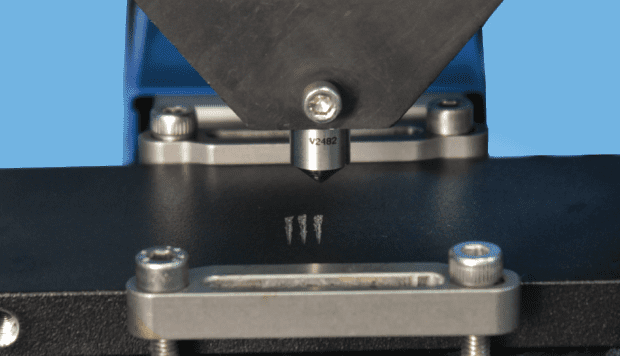
Comprensión de los fallos del revestimiento mediante ensayos de rayado
Introducción:
La ingeniería de superficies de los materiales desempeña un papel importante en diversas aplicaciones funcionales, que van desde el aspecto decorativo hasta la protección de los sustratos contra el desgaste, la corrosión y otras formas de ataque. Un factor importante y primordial que determina la calidad y la vida útil de los revestimientos es su fuerza cohesiva y adhesiva.

Escaneado de alta velocidad con perfilometría sin contacto
Introducción:
Las mediciones de superficies rápidas y fáciles de configurar ahorran tiempo y esfuerzo y son esenciales para el control de calidad, la investigación y el desarrollo y las instalaciones de producción. El Nanovea Perfilómetro sin contacto es capaz de realizar escaneados de superficies tanto en 3D como en 2D para medir características de escala nanométrica a macroescala en cualquier superficie, lo que proporciona una amplia gama de posibilidades de uso.
Categorías
- Notas de aplicación
- Bloque sobre tribología anular
- Tribología de la corrosión
- Pruebas de fricción | Coeficiente de fricción
- Pruebas mecánicas a alta temperatura
- Tribología de alta temperatura
- Humedad y gases Tribología
- Humedad Pruebas mecánicas
- Indentación | Fluencia y relajación
- Indentación | Resistencia a la fractura
- Indentación | Dureza y elasticidad
- Indentación | Pérdida y almacenamiento
- Indentación | Esfuerzo frente a deformación
- Indentación | Límite elástico y fatiga
- Pruebas de laboratorio
- Tribología lineal
- Pruebas mecánicas de líquidos
- Tribología de líquidos
- Tribología a baja temperatura
- Pruebas mecánicas
- Comunicado de prensa
- Perfilometría | Planitud y alabeo
- Perfilometría | Geometría y forma
- Perfilometría | Rugosidad y acabado
- Profilometría | Altura y grosor del escalón
- Profilometría | Textura y grano
- Perfilometría | Volumen y área
- Pruebas de perfilometría
- Tribología anillo sobre anillo
- Tribología rotacional
- Prueba de arañazos | Fallo adhesivo
- Prueba del rasguño | Fallo de cohesión
- Pruebas de arañazos | Desgaste en varias pasadas
- Pruebas de rayado | Dureza al rayado
- Pruebas de rayado Tribología
- Feria de muestras
- Pruebas de tribología
- Sin categoría
Archivos
- septiembre 2023
- agosto 2023
- junio 2023
- mayo 2023
- julio 2022
- mayo 2022
- abril 2022
- enero 2022
- diciembre 2021
- noviembre 2021
- octubre 2021
- septiembre 2021
- agosto 2021
- julio 2021
- junio 2021
- mayo 2021
- marzo 2021
- febrero 2021
- diciembre 2020
- noviembre 2020
- octubre 2020
- septiembre 2020
- julio 2020
- mayo 2020
- abril 2020
- marzo 2020
- febrero 2020
- enero 2020
- noviembre 2019
- octubre 2019
- septiembre 2019
- agosto 2019
- julio 2019
- junio 2019
- mayo 2019
- abril 2019
- marzo 2019
- enero 2019
- diciembre 2018
- noviembre 2018
- octubre 2018
- septiembre 2018
- julio 2018
- junio 2018
- mayo 2018
- abril 2018
- marzo 2018
- febrero 2018
- noviembre 2017
- octubre 2017
- septiembre 2017
- agosto 2017
- junio 2017
- mayo 2017
- abril 2017
- marzo 2017
- febrero 2017
- enero 2017
- noviembre 2016
- octubre 2016
- agosto 2016
- julio 2016
- junio 2016
- mayo 2016
- abril 2016
- marzo 2016
- febrero 2016
- enero 2016
- diciembre 2015
- noviembre 2015
- octubre 2015
- septiembre 2015
- agosto 2015
- julio 2015
- junio 2015
- mayo 2015
- abril 2015
- marzo 2015
- febrero 2015
- enero 2015
- noviembre 2014
- octubre 2014
- septiembre 2014
- agosto 2014
- julio 2014
- junio 2014
- mayo 2014
- abril 2014
- marzo 2014
- febrero 2014
- enero 2014
- diciembre 2013
- noviembre 2013
- octubre 2013
- septiembre 2013
- agosto 2013
- julio 2013
- junio 2013
- mayo 2013
- abril 2013
- marzo 2013
- febrero 2013
- enero 2013
- diciembre 2012
- noviembre 2012
- octubre 2012
- septiembre 2012
- agosto 2012
- julio 2012
- junio 2012
- mayo 2012
- abril 2012
- marzo 2012
- febrero 2012
- enero 2012
- diciembre 2011
- noviembre 2011
- octubre 2011
- septiembre 2011
- agosto 2011
- julio 2011
- junio 2011
- mayo 2011
- noviembre 2010
- enero 2010
- abril 2009
- marzo 2009
- enero 2009
- diciembre 2008
- octubre 2008
- agosto 2007
- julio 2006
- marzo 2006
- enero 2005
- abril 2004
